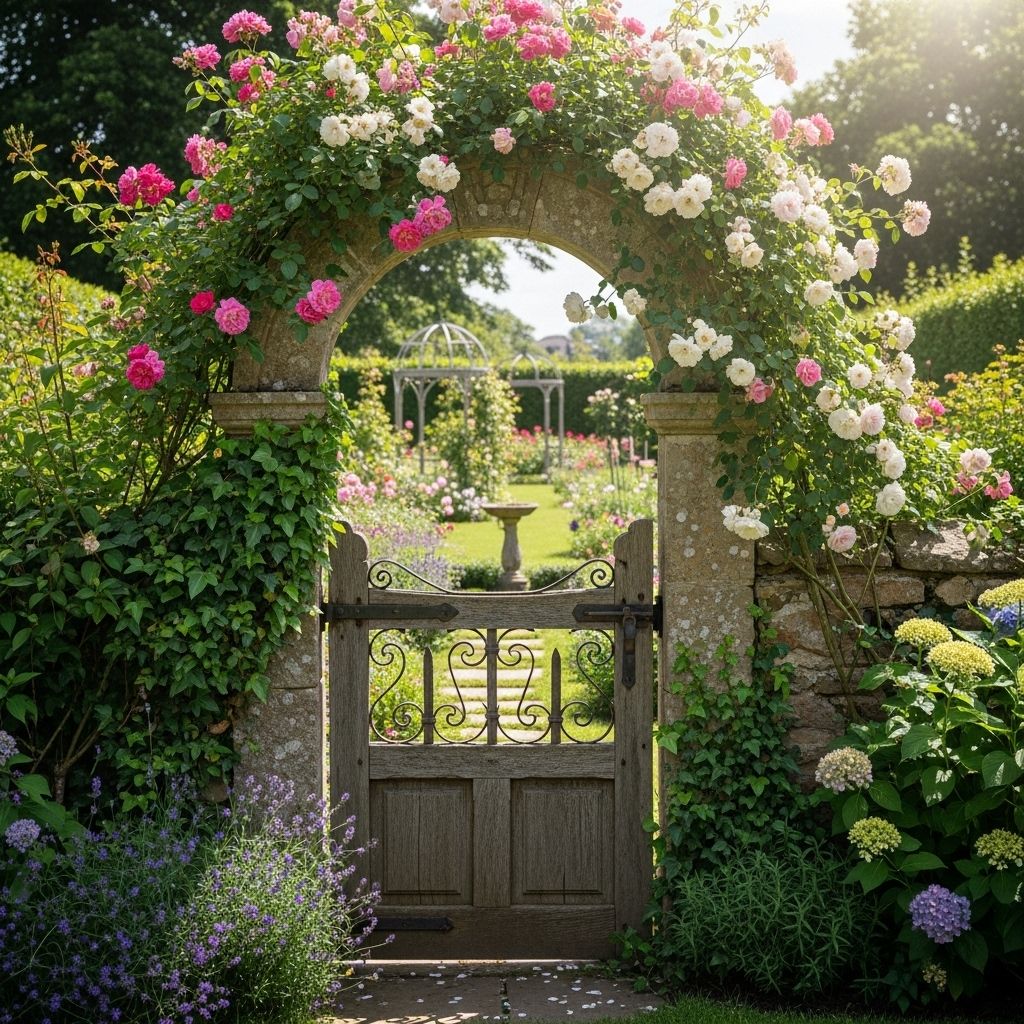Garden Gate Ideas: 6 Enchanting Portals To Enhance Your Garden
Discover how garden gates and portals create magical transitions between spaces in your landscape

Image: HearthJunction Design Team
The Enchanting Power of Garden Portals: Transforming Outdoor Spaces
A garden portal is more than just a practical entrance—it’s a magical threshold that transforms the experience of moving through outdoor spaces. Like the famous rabbit hole that beckoned Alice to Wonderland, a thoughtfully designed garden gate or portal invites curiosity, creates anticipation, and signals a transition from one world to another. These architectural elements serve as both functional passageways and artistic statements that enhance the narrative of your garden journey.
Garden portals come in many forms—gates, arbors, arches, and more—each offering unique opportunities to define spaces, frame views, and create memorable moments in the landscape. When designed with intention, these transitions become powerful focal points that elevate the entire garden experience, drawing visitors forward with the promise of discovery.
The Transformative Power of Garden Portals
A garden gate is a portal that signifies a transition into a new space and experience. Like Alice looking down the rabbit hole, a gate leads us from the known to the unknown. These thresholds mark boundaries while simultaneously inviting exploration, creating a sense of journey through the landscape. The most effective garden portals don’t merely connect spaces—they tell a story and evoke emotion.
When you elongate or accentuate the portal, the transition becomes even more tantalizing. A longer passageway, an extended arbor, or a series of gates creates a more dramatic experience, building anticipation as visitors move from one garden room to the next. This sense of passage is fundamental to how we experience gardens, transforming a simple walk into a meaningful journey.
The Covered Gate: Classic Protection with Style
The covered gate represents one of the most enduring and practical portal designs. Beyond its obvious function of providing shelter from the elements, a covered gate serves as an architectural statement that anchors the garden entrance. The example shown in the original inspiration features an old gate renovated with new hinges, roofing, and a fresh coat of paint—demonstrating how existing elements can be refreshed rather than replaced.
A key design element of this covered gate is the bluestone threshold that extends outward on both sides. Thresholds serve a dual purpose: they prevent the ground beneath the gate from becoming soggy and compacted, while visually inviting people to enter. This practical feature enhances both the longevity of the structure and the welcoming nature of the entrance.
Complementing this particular covered gate is Salix integra ‘Hakuro-nishiki’ (dappled willow), a striking shrub with variegated foliage that adds visual interest near the entrance. This thoughtful plant selection demonstrates how vegetation can enhance the portal experience, creating a harmonious relationship between structure and landscape.
The Surprise Gate: Hidden Treasures
Perhaps the most delightful of all garden portals is the surprise gate—an unexpected entrance discovered while wandering through the landscape. These hidden passages create moments of discovery that make a garden exploration truly memorable. Tucked around corners or nestled within lush plantings, surprise gates reward the curious visitor with new vistas and secret spaces.
The lattice construction commonly used for surprise gates serves both aesthetic and practical purposes. The open framework allows breezes to flow through, creating a gentle, inviting transition rather than an abrupt barrier. This permeability makes the gate feel like a secret passage to undiscovered parts of the property, enhancing the sense of mystery and adventure.
In the example that inspired this article, yellow-flowered hibiscus shrubs surround the surprise gate, creating a vibrant frame that draws attention to the entrance while partially concealing it. This strategic combination of revelation and concealment is what makes surprise gates so effective—they balance the thrill of discovery with the promise of what lies beyond.
The Rustic Arbor: Natural Elegance
Rustic arbors bring a sense of timeless charm to garden entrances, combining architectural structure with the beauty of climbing plants. These portals often feature natural materials and simpler construction that harmonizes with more casual or naturalistic garden styles. The rustic quality doesn’t diminish their impact—instead, it creates a lived-in, established feel that suggests the garden has evolved over time.
When designing a rustic arbor, proportion and scale are critical considerations. As a general rule, the area extending in front of and behind the arbor should be at least half the height of the arch. For example, an 8-foot-high arched gate would require attention to the 4 feet of space on either side to create a cohesive entry experience. This spatial relationship ensures the portal feels balanced and properly integrated with the surrounding landscape.
Climbing plants like Goldflame Honeysuckle can transform a simple rustic arbor into a living sculpture. As these plants mature, they soften the structure’s lines and create a more immersive experience when passing through. The seasonal changes of flowering vines add another dimension to the portal, making it an ever-evolving feature that marks the passage of time in the garden.
Classic Arched Trellis: Vertical Drama
The classic arched trellis stands as one of the most recognizable and versatile garden portals. Available in wood, metal, or wrought iron, these structures create instant vertical interest in the landscape. Their graceful curves evoke romantic, timeless feelings while providing a sturdy framework for climbing plants.
An arched trellis serves as more than just a passageway—it becomes a focal point that adds structure and intentional design to the garden. The defined shape creates a strong architectural presence that can anchor a garden view or mark an important transition between spaces. Even without plantings, the clean lines and elegant proportions of a well-designed arch make a powerful statement.
For maximum impact, consider illuminating your arched trellis with garden lights. Strategic lighting transforms the portal after dark, creating dramatic silhouettes and extending the usefulness and beauty of the garden into the evening hours. This simple addition can turn a daytime passageway into a nighttime focal point, highlighting the portal’s architectural details.
Living Portals: Green Gateways
For those seeking a more organic approach to garden transitions, living portals offer a unique solution that blends structure and nature. Living willow arches represent one popular approach, using flexible willow stems that are planted and woven into archways. These structures take root and grow, creating a truly living passage that changes with the seasons.
Living portals attract wildlife, adding ecological value to their aesthetic appeal. Birds may nest in the dense growth, while pollinators visit the flowers of climbing plants. This added layer of garden activity brings movement and sound to the portal area, enhancing the multi-sensory experience of passage.
The year-round interest of living portals makes them especially valuable in the garden. From the bright green of new spring growth to the architectural beauty of bare branches in winter, these transitions mark seasonal changes while maintaining their function as defined pathways through the landscape.
The Secret Garden Door: Mystery and Charm
Few garden elements capture the imagination like a secret garden door—a portal that promises hidden delights beyond. These entrances often incorporate solid doors set within walls or hedges, concealing what lies on the other side and creating a moment of revelation when opened. The contrast between enclosure and discovery makes these portals particularly powerful in the landscape narrative.
Secret garden doors tap into cultural associations with enchanted places, reminiscent of beloved stories like “The Secret Garden.” This connection to collective imagination adds depth to the garden experience, transforming a simple passage into a meaningful journey. Visitors instinctively slow down and pay attention when encountering such portals, enhancing their appreciation of the spaces beyond.
To maximize the impact of a secret garden door, consider how it reveals the space beyond. A narrow opening that gradually discloses a larger garden creates more drama than a wide entrance that shows everything at once. This controlled revelation is part of the portal’s storytelling power, building anticipation and rewarding curiosity.
Design Considerations for Garden Portals
When planning a garden portal, several key design principles will help ensure its success in the landscape:
- Context matters – The style, materials, and scale of your portal should harmonize with both the architecture of your home and the character of your garden.
- Threshold design – Pay attention to the ground beneath and around your portal, using high-quality materials that stand up to frequent foot traffic.
- Proportion and scale – Ensure that the area extending before and after the portal supports its vertical presence, typically at least half the height of the structure.
- Plant integration – Select complementary plants that enhance rather than overwhelm the portal, considering seasonal interest and maintenance needs.
- Visibility and discovery – Decide whether your portal should be a prominent focal point or a hidden surprise, and design the surrounding landscape accordingly.
By thoughtfully applying these principles, your garden portal will become more than just an entrance—it will become a memorable experience that enhances the entire landscape.
Frequently Asked Questions
What is the purpose of a garden portal?
A garden portal serves multiple purposes: it creates a transition between different garden spaces, provides a sense of journey and discovery, establishes boundaries, frames views, and adds architectural interest to the landscape. Beyond these practical functions, portals add narrative depth to gardens, making the experience of moving through outdoor spaces more meaningful and memorable.
What materials work best for garden gates and portals?
The best materials depend on your garden style, climate, and maintenance preferences. Wood offers traditional charm but requires regular maintenance. Metal provides durability and can range from ornate wrought iron to sleek contemporary designs. Stone creates substantial, permanent portals ideal for formal gardens. Living materials like willow or trained hedges offer a natural approach that integrates completely with the landscape.
How do I ensure my garden portal is in proportion to the space?
A good rule of thumb is to ensure that the area extending in front of and behind the portal is at least half the height of the structure. For example, an 8-foot tall arbor should have at least 4 feet of thoughtfully designed space on either side. Also consider the width of the opening in relation to the expected flow of traffic—wider for main pathways, narrower for more intimate garden discoveries.
What climbing plants work well on garden portals?
Popular choices include climbing roses for romantic charm and fragrance, wisteria for dramatic cascades of flowers (though it requires sturdy support), clematis for varied colors and bloom times, honeysuckle for fragrance and wildlife value, and ivy for year-round coverage. Consider the weight of mature plants, bloom time, growth rate, and maintenance requirements when selecting climbers for your portal structure.
How can lighting enhance a garden portal?
Strategic lighting transforms garden portals after dark, extending their beauty and functionality into evening hours. Downlighting from within a covered structure creates a welcoming glow, while uplighting against an arbor or arch emphasizes its architectural form. Solar-powered path lights can safely guide visitors through the portal, while string lights add a magical, festive atmosphere for special occasions.
References
- https://www.gardendesign.com/pictures/the-power-of-a-garden-portal_455/
- https://serenityinthegarden.blogspot.com/2010/01/more-on-portals-in-landscape-design.html
- https://www.backyardboss.net/8-ways-to-add-a-garden-portal-to-your-landscaping/
- https://www.pinterest.com/pin/272045633718605992/
- https://gatewise.com/blog/garden-style-apartments
Read full bio of Anjali Sayee












